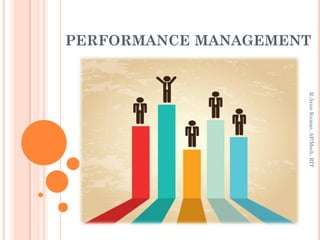Performance management
- 2. PEFORMANCE MANAGEMENT: Performance management is defined as the process of evaluating employee performance on the job in terms of job requirements. R.ArunKumar,AP/Mech,RIT
- 3. PEFORMANCE APPRAISAL: Performance appraisal is the systematic evaluation of the individual with regard to his or her performance on the job and his potential for development. R.ArunKumar,AP/Mech,RIT
- 4. OBJECTIVE OF PERFORMANCE APPRAISAL: To improve employee’s performance. To review the performance of the employees over a given period of time. To judge the gap between the actual and desired performance. R.ArunKumar,AP/Mech,RIT
- 5. OBJECTIVE OF PERFORMANCE APPRAISAL: To help management in exercising organizational control. Helps to strengthen the relationship and communication between superior – subordinates and management – employees. To diagnose the strengths and weaknesses of the individuals so as to identify the training and development needs of the future. R.ArunKumar,AP/Mech,RIT
- 6. OBJECTIVE OF PERFORMANCE APPRAISAL: To improve employee’s performance. To provide feedback to the employees regarding their past performance. Provide information to assist in the other personal decisions in the organization. R.ArunKumar,AP/Mech,RIT
- 7. OBJECTIVE OF PERFORMANCE APPRAISAL: Provide clarity of the expectations and responsibilities of the functions to be performed by the employees. To judge the effectiveness of the other human resource functions of the organization such as recruitment, selection, training and development. To reduce the grievances of the employees. R.ArunKumar,AP/Mech,RIT
- 8. PROCESS OF PERFORMANCE APPRAISAL: R.ArunKumar,AP/Mech,RIT
- 9. PERFORMANCE APPRAISAL METHODS: 1. Written Essay: An evaluator writes out a description of an employee's strengths and weaknesses, past performance, and potential. The evaluator would also make suggestions for improvement. R.ArunKumar,AP/Mech,RIT
- 10. PERFORMANCE APPRAISAL METHODS: 2. Critical incidents: An evaluator will be considering only specific behaviours, not vaguely defined personality traits, are cited. R.ArunKumar,AP/Mech,RIT
- 11. PEFORMANCE APPRAISAL METHODS: 3. Graphic Rating Scales: Employee will be evaluated on various criteria (especially on his quality in all kind of job) on scale basis. R.ArunKumar,AP/Mech,RIT
- 12. PEFORMANCE APPRAISAL METHODS: 4. Behaviorally Anchored Rating Scales: The appraiser rates an employee according to items along a numerical scale, but the items are examples of actual behaviour on a single job rather than general descriptions or traits. R.ArunKumar,AP/Mech,RIT
- 13. PEFORMANCE APPRAISAL METHODS: 5. Multi person comparison: Employees are compared with work output of other fellow employees. The three most popular approaches to multi person comparisons includes: 1. Group order ranking 2. Individual ranking 3. Paired comparison. R.ArunKumar,AP/Mech,RIT
- 14. PEFORMANCE APPRAISAL METHODS: 6. MBO: Employees are evaluated by how well they contribute to the organization. R.ArunKumar,AP/Mech,RIT
- 15. PEFORMANCE APPRAISAL METHODS: 7. 360° Appraisal: Feedback will be received from supervisors, employees and co- workers, etc. peer R.ArunKumar,AP/Mech,RIT

